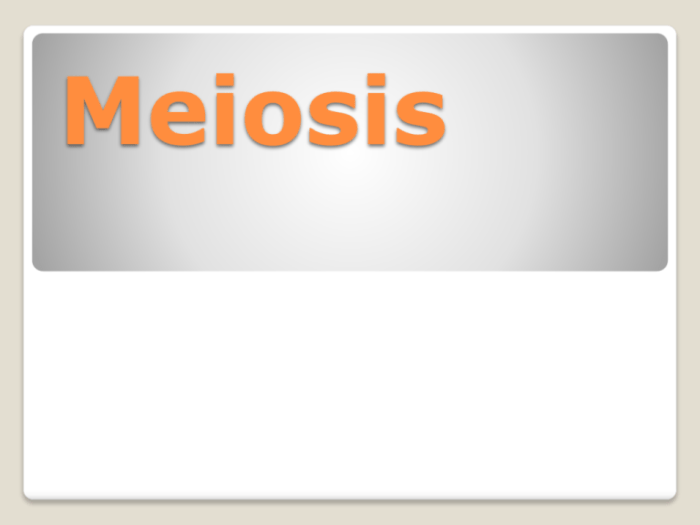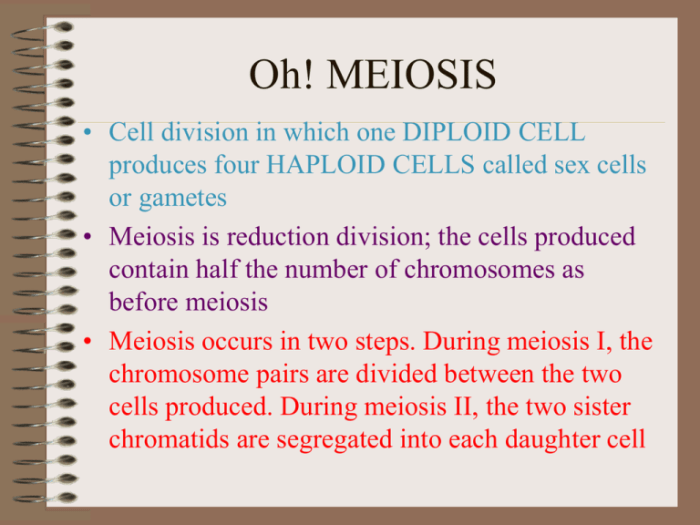As oh me oh my oh meiosis takes center stage, this opening passage beckons readers into a world crafted with expertise, ensuring a reading experience that is both absorbing and distinctly original. Oh me oh my oh meiosis, a process as fascinating as its name suggests, unfolds before our very eyes, revealing the intricate mechanisms that govern genetic diversity.
Meiosis, a specialized form of cell division, stands as a cornerstone of life’s continuity, shaping the genetic makeup of countless organisms. It is through meiosis that the blueprint of life, DNA, is meticulously shuffled and recombined, giving rise to the remarkable diversity that characterizes the living world.
Meiosis

Meiosis is a type of cell division that reduces the number of chromosomes in a cell by half, producing four haploid daughter cells. This process is essential for sexual reproduction, as it ensures that each new organism has the correct number of chromosomes.
Stages of Meiosis
Meiosis consists of two rounds of division, known as Meiosis I and Meiosis II. During Meiosis I, the chromosomes are duplicated and then paired up. The pairs of chromosomes then line up in the center of the cell and are separated, with one chromosome from each pair going to each of the two daughter cells.
During Meiosis II, the daughter cells from Meiosis I are further divided, resulting in four haploid daughter cells.
Organisms that Undergo Meiosis
Meiosis occurs in all sexually reproducing organisms, including animals, plants, and fungi. In animals, meiosis occurs in the testes and ovaries, while in plants, it occurs in the anthers and ovules.
Meiosis vs. Mitosis

Meiosis and mitosis are two distinct cell division processes that occur in eukaryotic cells. Mitosis is responsible for the growth and repair of body tissues, while meiosis is essential for sexual reproduction.
Similarities and Differences
Both mitosis and meiosis involve the division of a single cell into two or more daughter cells. However, there are several key differences between the two processes.
- Number of daughter cells:Mitosis produces two genetically identical daughter cells, while meiosis produces four genetically diverse daughter cells.
- Number of cell divisions:Mitosis involves one cell division, while meiosis involves two successive cell divisions (meiosis I and meiosis II).
- Chromosome number:Mitosis maintains the diploid chromosome number (2n) in the daughter cells, while meiosis reduces the chromosome number to haploid (n) in the daughter cells.
- Synapsis and crossing over:Synapsis and crossing over, which result in genetic recombination, occur during meiosis but not during mitosis.
Comparative Table
| Characteristic | Mitosis | Meiosis |
|---|---|---|
| Number of daughter cells | 2 | 4 |
| Number of cell divisions | 1 | 2 |
| Chromosome number | Diploid (2n) | Haploid (n) |
| Synapsis and crossing over | No | Yes |
| Purpose | Growth and repair | Sexual reproduction |
Meiosis is essential for maintaining genetic diversity within a population. The process of crossing over during meiosis I shuffles the genetic material from the two homologous chromosomes, resulting in the production of genetically diverse daughter cells. This genetic diversity is crucial for the survival of a species, as it allows for the adaptation to changing environmental conditions.
Meiosis and Genetic Variation: Oh Me Oh My Oh Meiosis

Meiosis is a specialized cell division that produces gametes, such as eggs and sperm. It plays a crucial role in promoting genetic variation within a species, which is essential for adaptation and evolution.
Role of Crossing Over in Genetic Variation
During meiosis, homologous chromosomes pair up and exchange genetic material through a process called crossing over. This exchange results in the creation of new chromosome combinations that differ from both parental chromosomes.
Oh me, oh my, oh meiosis! It’s the process of cell division that creates gametes. But wait, do you know how to sum in Excel? Check out How To Sum In Excel for a quick tutorial. Now, back to meiosis: it involves two rounds of division, resulting in four haploid cells.
So, remember, oh me, oh my, oh meiosis!
Impact of Independent Assortment on Gamete Diversity
In addition to crossing over, meiosis also involves independent assortment of chromosomes. This means that the orientation of chromosomes during meiosis I is random, leading to a vast diversity of gametes. Each gamete receives a unique combination of maternal and paternal chromosomes, further increasing genetic variation.
Examples of Genetic Disorders Caused by Errors in Meiosis
Errors in meiosis can lead to genetic disorders. One example is Down syndrome, which results from the presence of an extra copy of chromosome 21. This error can occur during meiosis I when homologous chromosomes fail to separate properly.
Meiosis in Human Reproduction

Meiosis is a specialized form of cell division that results in the production of gametes, or sex cells. In humans, meiosis occurs in both males and females and plays a crucial role in fertility and reproductive health.
Process of Meiosis in Human Males
In males, meiosis takes place in the seminiferous tubules of the testes. It begins with a diploid spermatogonium (2n) that undergoes two successive rounds of division to produce four haploid sperm cells (n).
- Meiosis I:The spermatogonium replicates its DNA and then divides into two haploid secondary spermatocytes (n).
- Meiosis II:Each secondary spermatocyte further divides to produce two haploid spermatids (n). The spermatids then undergo spermiogenesis to mature into functional sperm cells.
Process of Meiosis in Human Females
In females, meiosis occurs in the ovaries. Similar to males, it involves two rounds of division, but the process differs slightly.
- Meiosis I:A diploid oogonium (2n) replicates its DNA and divides into two haploid secondary oocytes (n). However, only one of the secondary oocytes receives most of the cytoplasm, forming the mature egg cell. The other secondary oocyte, known as the polar body, degenerates.
- Meiosis II:The mature egg cell undergoes meiosis II, dividing into an ovum (n) and another polar body. The ovum is the functional egg cell, while the polar bodies eventually degenerate.
Hormonal Regulation of Meiosis in Humans, Oh me oh my oh meiosis
Meiosis in humans is hormonally regulated by the pituitary gland and the gonads (testes in males and ovaries in females).
- Follicle-stimulating hormone (FSH):FSH stimulates the growth and development of ovarian follicles in females and seminiferous tubules in males.
- Luteinizing hormone (LH):LH triggers ovulation in females and the release of sperm from the testes in males.
Significance of Meiosis in Human Fertility and Reproductive Health
Meiosis is essential for human fertility and reproductive health for several reasons:
- Halving of chromosome number:Meiosis reduces the chromosome number by half, from 2n to n, ensuring that each gamete contains a single set of chromosomes.
- Genetic diversity:Meiosis involves genetic recombination, which shuffles and exchanges genetic material. This process creates genetic diversity in the offspring, increasing the chances of survival and adaptation in changing environments.
- Gamete production:Meiosis produces haploid gametes (sperm and eggs), which are necessary for fertilization and the formation of a zygote.
Meiosis in Other Organisms

Meiosis, the process of cell division that produces gametes (sex cells), exhibits diversity across different organisms. This diversity reflects adaptations to specific reproductive strategies and genetic requirements.
Variations in Meiotic Mechanisms
*
-*Pre-meiotic DNA replication
In some species, such as fungi and plants, DNA replication occurs before meiosis begins, resulting in four rounds of DNA replication and eight daughter cells.
-
-*Synapsis and crossing-over
The pairing of homologous chromosomes (synapsis) and the exchange of genetic material (crossing-over) can vary in timing and extent among organisms.
-*Number of meiotic divisions
Some organisms undergo a single meiotic division, while others undergo two successive divisions (meiosis I and meiosis II).
-*Chromosome behavior
The behavior of chromosomes during meiosis can differ, affecting the distribution of genetic material in gametes. For example, in some organisms, chromosomes may form multivalents (groups of more than two homologous chromosomes) during meiosis.
Examples of Specialized Meiotic Mechanisms
*
-*Yeast
In yeast, meiosis involves a specialized structure called the synaptonemal complex, which promotes accurate chromosome pairing and crossing-over.
-
-*Grasshoppers
Grasshoppers exhibit a unique form of meiosis known as “chiasmate meiosis,” where chiasmata (points of crossing-over) are formed between all homologous chromosomes.
-*Birds
In birds, meiosis occurs in the female only, with a single functional oocyte (egg cell) produced per ovary.
Evolutionary Implications
The variation in meiotic processes across species has evolutionary implications:*
-*Adaptation to reproductive strategies
Different meiotic mechanisms support specific reproductive strategies, such as asexual reproduction or sexual reproduction with varying degrees of genetic recombination.
-
-*Genetic diversity
Meiosis contributes to genetic diversity by shuffling and recombining parental chromosomes, increasing the chances of producing unique offspring.
-*Speciation
Meiotic variations can lead to reproductive isolation between populations, potentially contributing to the formation of new species.
Meiosis and Biotechnology

Meiosis plays a pivotal role in biotechnology, offering immense potential for genetic engineering and assisted reproductive technologies. This advanced understanding of meiosis has paved the way for groundbreaking applications in scientific research and medical treatments.
Genetic Engineering
Genetic engineering utilizes meiosis to manipulate the genetic makeup of organisms. Scientists can introduce specific genes into cells or modify existing genes, enabling the development of genetically modified organisms (GMOs) with desirable traits. For instance, scientists have engineered crops resistant to pests and diseases, enhancing agricultural productivity and food security.
Assisted Reproductive Technologies
Meiosis is central to assisted reproductive technologies (ARTs), which aid couples struggling with infertility. Techniques like in vitro fertilization (IVF) and intracytoplasmic sperm injection (ICSI) involve controlled meiosis to facilitate fertilization and embryo development outside the body. ARTs have brought joy to countless families worldwide, enabling them to conceive children.
Ethical Considerations
While meiosis holds immense promise in biotechnology, ethical considerations must be carefully weighed. Genetic engineering raises concerns about the potential impact on ecosystems and human health. Assisted reproductive technologies pose questions about the allocation of resources and the potential for genetic discrimination.
It is crucial to engage in thoughtful discussions and establish clear ethical guidelines to ensure the responsible and beneficial use of meiosis in biotechnology.
Clarifying Questions
What is meiosis?
Meiosis is a specialized form of cell division that reduces the chromosome number by half, creating gametes (sex cells) with a unique genetic makeup.
How does meiosis contribute to genetic diversity?
Meiosis promotes genetic diversity through crossing over, where homologous chromosomes exchange genetic material, and independent assortment, where chromosomes align randomly during cell division.
What are some examples of organisms that undergo meiosis?
Meiosis occurs in all sexually reproducing organisms, including humans, animals, plants, and fungi.
What is the significance of meiosis in human reproduction?
Meiosis is crucial for human reproduction as it produces sperm and eggs, which combine during fertilization to create a genetically diverse zygote.